|
|
Visitor Management Ranger 1996 to present
Interviewer: Vanessa Ryan
Just for the record, may I ask your name?
I am Jolene McLellan and I'm the Visitor Management Ranger at Girraween.
[Laughs.] You got ahead of me! Ok... So... you are still working here?
I am. I've been here for twenty years now. I started in August 1996 as an Interpretation Ranger, or a Public Contact Ranger is another name they call it. It was in 2012 they changed my position where I don't just work at Girraween. I'm actually working on regional projects for the southwest region and they changed my title to Visitor Management Ranger.
|
|
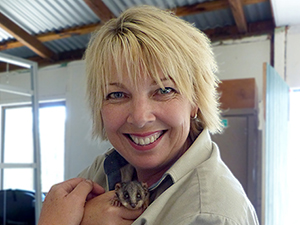
Jo McLellan with an orphaned baby
Ring-tail Possum. A park neighbour had
brought it in during the interview.
|
|
So, having your position expanded, does that mean different sorts of tasks you have to do?
Yes. Basically, beforehand, it was all about Girraween. So that was doing everything from fire management, pest management, looking after our facilities, all the public contact - obviously - and the admin.. So when they changed my position, the way they described it to me was I would be doing less of the routine stuff - like cleaning toilets - and more project work. I guess that's how it's panned out. I still do the good stuff, the fun stuff in Girraween like fire management and a bit of pest management and so on, but yeah, I'm now working on more projects throughout the region, as well as in Girraween.
When you are saying projects, you mean public contact projects?
|
|
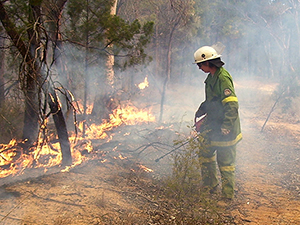
Helping with fire management.
|
|
Yes, larger projects that might be funded - $50,000 or $100,000 projects. For example, one I'm working on - which is pretty cool - is a mining company gave National Parks $100,000 to do up some facilities in Minerva Hills National Park, which is out near Springsure, out near Carnarvon Gorge. We basically could do what we want with this money - not so much on infrastructure, but on things for the public... So signage, barbecues, we've got some interpretive shelters with some little kids activities, some lookout signage. So right up my alley. I love it. It's good fun.
Sounds good. So you've been here for twenty years. Had you ever been to Girraween before you started working here?
I actually hadn't. My first day I started working was on the 19th of August, 1996. I was little Brisbane girl, originally from New Zealand, but I did my schooling in Brisbane, so I had no idea that there were these cold places in Queensland. So I rocked up with just a shirt and jeans and froze my ... off the evening before. And I walked out of the barracks, which is where I stayed the night before. I walked out, and on my very first day, it's snowing. [Laughs.]
Really?
Yeah. So I had to borrow some clothes from the guys and, yes, I soon learned that Girraween is one of the coldest places in Queensland.
Well, welcome to Giraween! I'll snow on you! So how did you come about working here?
I went on a guided walk training course in Brisbane... Oh hang on, I should take you back. I went to Uni.. I did the Gatton course that Brett talked about... So I went to Gatton Uni when I was twenty-four - it was in 1994 and 1995 and I had gone back as a mature-aged student. I wasn't terribly mature, but I was aged! [Laughs.]
You'd reached a point in your life where you realised this is what I want to do?
I had no idea before that. I was in hospitality way before that. I knew that I loved working with people, but in the hospitality industry, it was just, yeah, not my cup of tea. It was actually a night in Cape Tribulation that did it for me. It was kind of my turning point. We were sort of lying down looking up at the trees and the stars. You know, possums and birds and owls and things all around and me sort of saying... and yes, this was after a couple of drinks... saying I really love nature. I wish I could do more. And so, at that stage I started looking for courses and the best I could come up with was the Wildnerness and Wildlife Associate Diploma at Gatton Uni.
And that's two years?
That's the two years, yep. It was very practical. There were a lot of hands-on type subjects, but there was also some theory as well that went with it. And it just gave you a really good touch of what jobs you could sort of dabble in if you wanted to work in the environment.
When I was at uni, you had to do placement, so I kind of played around. I worked with Totally Wild for a week. I went to the Northern Territory and worked in a National Park there. I helped the Koala Foundation out with a wildlife survey. So all these different things because I didn't quite know what I wanted to do. It was when I was in the Northern Territory and helped out with some interpretive work - taking people on guided walks and interpreting the environment - that I thought this is probably where I should be because I do love people and I love trying to encourage people also to love what I do. So I kind of went from there.
So yeah, I did this two day guided walk training course in Brisbane and I met the Ranger in Charge of Girraween from that time there. His name was John Moye. I kind of said to him after a couple of days getting to know him, what do I need to do? I was at the time working in Gondwana Wildlife Sanctuary - I worked there while I was at uni.. Yeah, I said to him, I wanted to get out of the city and I wanted to get into National Parks, what do I need to do? And he said, well look, I've got ten weeks work available, because the girl that was in my job now, was going on leave. And he said, if you want it, it's yours. I can make it happen. So I asked my boss at the time if I could have ten weeks off work. He said no, so I said, ok I quit. [Laughs.]
I packed my car up, packed my dog in with me and off we went... We came and I worked the ten weeks, then I stayed on as a Volunteer for a couple more months. I did some cherry picking to pay my way. The girl that came back to her job decided then she was going to move to Brisbane and make a family. So eventually John got permission to put somebody on until they filled the position. He was able to put me on, which was great, and then they advertised the position. I was up against about eighty other people and I got the job, which was pretty cool. It was the highlight of my life really, getting a job as a ranger.
You obviously love it. You've been doing it for so long.
Oh, yeah. I do. You can kind of tell. Twenty years here, you know. I'm captivated by this place. I mean I do love other National Parks, but this place is in my blood. You know, I love it and will probably be here until I'm eighty.
[Both laugh.]
And they'll probably let you stay, too. Um... So who were you working with over the years?
Ok, so John Moye, he was the Ranger in Charge - acting - at the time. And then there was Glen and Ian Elms, so they're the twin brothers that took on from Bill and Hock, back in the eighties. So yeah, we were the main ones and we had some temporary rangers that would come along as well. Stubbie eventually left and so did John.
I, at some stage in there, acted as Ranger in Charge for - pretty much on and off in my career - I've probably filled in for about three years. I just missed working with Brett. He had already moved to Toowoomba, so he's always been my District Ranger or Senior Ranger. I have a lovely connection with Brett. I have lots of admiration for him. He's a really good boss, yeah.
So John Moye, then we had Peter Lindsay, we've had Jamie Seeleither... There was a stack of people that have been in that position I guess.
My favourite Ranger in Charge of all time is John Cowburn. He came along and he was with us for ten years. A great man. Done some amazing things for the park and just a really good bloke to work for and with. We had a really good team in that decade. We've had Justin and Karl join. And Neal... I can't remember the order, I think Neal came along first and then Justin and Karl... I guess that's the best team I've ever worked with. We just have such respect for each other and really look after each other. Especially in this type of job, you know? You are in life-threatening situations and when you can look at who's driving beside you and you can trust that person will look after you, then that's pretty cool.

The 2010 team of Girraween Rangers - from left to right:
Karl Braund, Jolene McLellan, John Cowburn (now retired), Sue Smith, Neal Holmes, Justin Wheatley.
I can understand that totally, yeah.
And we've got a good team now. We've got a larger team, that's for sure...
Did you say, there's eight people?
Yeah. So we have Greg on board. We have Peter - he's our second in charge. We have Neal and Justin, Karl, Steven, myself, Sue and Ian.
So two ladies?
So there's nine of us... Sue's a casual. Yeah, two ladies. Sue and I, we actually share a position.
From all the names you've mentioned, the majority have been men. Are there many women in the National Parks service?
Well, I wouldn't say it was fifty fifty, but there are some women and a lot of women are in managerial-type positions. You know, the authorative postitions. I guess out in the field we are probably a bit limited in numbers, yeah. Men seemed to be more attracted to these types of jobs, but in saying that, I mean, in the Central Region there's a lot more females than males. So it does differ.
I suppose it just depends what people are interested in doing.
Yeah. I guess in my region it's hard because there's a lot of remote parks, so you know, you have got to have a pretty thick skin to be out in those parks. It makes it hard if you've got family, it makes it hard if you're a single person wanting to seek a mate... You know?
Yeah. You've got to see that rangers are human beings. They have lives.
They do, they do.
So you've said some of the things you do. What other sort of duties do you do here?
So, a day in the life of Jo at the moment is... Unfortunately, a lot of it is sitting in the office doing projects. Planning and following through... But it's cool stuff. Like I mean, for this project that I talked about with Minerva Hills, I'm designing ten signs. So, you know, it's cool. You get to be creative and think about some new products that you can use and that sort of thing.
|
|
I guess it's like any ranger position, it does depend what's going on out in the natural world as to what you do in your day. So yes, it's seasonal. Winter time, I'll hardly be in that office, I'll be out burning off with the boys. Helping them out with the fire management projects. Autumn, I'll be out doing wombatting - you know, making sure that my cameras are working and I'm getting some cool footage. That's been my little project that I've continued to take on over the years. But yes, obviously Spring and Summer are our busy times. There's a lot of visitor stuff going on in Girraween as well as working on my projects for other parks.
So, while you're working here in Girraween... You did the tour this morning, which was great thank you... Do you do many of those sorts of tours?
|
|
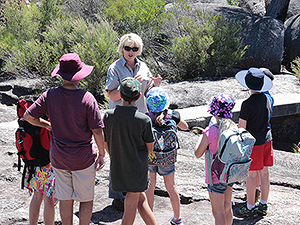
Jo leading a group on a guided walk.
|
|
We try to. We have a lot of school groups that are coming through each year so we try and talk to those groups as much as we can. They are the younger generation that we are after...
[Interruption when a park neighbour brought in an orphaned baby Ringtail Possum for Jo to look after.]
|
|
You were talking about wombatting before?
Oh wombatting. Autumn is my favourite time of the year because it's when I get to get out and check our wombat population. See if they are doing what they should be doing. During May especially, they are preparing their burrows for the winter months ahead. So you usually see a pile of dirt at the entrance of their burrows where they clean all the dirt out. So I set up cameras on those burrow systems and hope to capture footage of the wombats doing their thing.
So you have an idea of where they are living in the park and you go out and walk around to see which burrows are active?
Yep. And set up the cameras and obtain all this really fantastic footage of them going about their ways.
Cool...
|
|
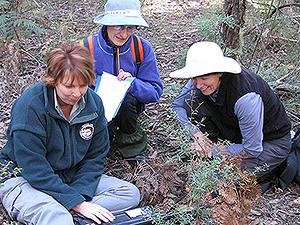
Jo wombatting with some helpers.
|
|
Another thing through the Autumn months is we hear our Superb Lyrebirds. I have been known to set up cameras on the Lyrebird mounds as well and capture footage. And that's, you know, just going on from the great work that Bill Goebel has done with recording the Lyrebirds. So yeah, I'm just capturing video of them as well.
Cool. You said you also design things? Have you had any training in designing or did you go away and learn how to use Photoshop or whatever just all on the job?
No, it's all on the job. I guess this is the thing when you work in National Parks, that you do have to adapt and come up with creative means to get around things because sometimes there mightn't be budgets and things available for you. So you just come up with the means and ways yourself. So yes, a lot of computer work. You've got to teach yourself how to do these things, but there is at some point where you go, yeah, I need to consult a graphic artist or designer or whatever to do the work.
I'm sure you get lots of support.
Yeah, most of the time.
You have your little network that you can ask "how do I do this?"
Absolutely, yeah.
Ok, on to the next question. What is your biggest achievement while you've been here?
Oh gee... My biggest achievement?
The thing you are proudest of.
I guess what I am most proud of is my passion. Going through with what I started out to do, which was I wanted to help care for nature and then working out that education was the key, for me, because yeah, I love working with people. To be able to try and encourage others to feel the way you do is really quite satisfying. That could be a selfish thing, but in the long run, yeah, I just want to help protect our beautiful environment and all creatures great and small. So, at the end of the day, I think, yeah, that my passion and my motivation have been the keys to making that happen.
I'm sure that over the course of twenty years and having spoken to so many school children, that you will have probably affected a few lives. And made people much more aware of the environment around them. And to appreciate it.
I hope so. I've also tried to raise the profile of being a Ranger as well. It's not just about playing with animals, you know. That's not what we do. We are the front line protectors of nature. And outside of work, I'm working with our Queensland Rangers Association. That's also very satisfying because there are rangers all throughout the world and it's universal that what we do is important. We need protection and need to look after each other and share ideas and so on.
But yeah, I guess, back to it, I am pretty proud that I do still love my job. That I can't wait - say, after having two weeks holiday - I can't wait to come back to work. I still love my job and I work with some amazing people. I'm still learning things as I go. I've got a LOT to learn, in fact. I do have a pretty cool job and I know and appreciate that.
I envy you, I really do.
[Both laugh.]
While you've been here, have you had any major fires, floods or other natural disasters you've had to deal with?
Yeah. So I started in '96. At that stage, our biggest wildfire was '94, so we then got our even bigger wildfire in 2002. We had some minor ones in between. 2005, Christmas Day, was probably one of my scariest days. It's when a burning tree fell on the car I was driving in and it actually missed my head by inches. If you can imagine the back of a truck, the back left hand side was down to the ground. It was like a tin opener had bent it.
So you were driving at the time the tree fell on you, while you were moving?
It fell and I accelerated and thank goodness I did because it hit the truck and then rolled down the back and bent the back tray.
You had no injuries?
No. I just cried.
I don't blame you. I would have too!
Yeah.
Ah, here we go. Did it ever snow while you were here?
Hmmmm. That's a bit of a touchy subject. I have seen many forms of snow as far as sleet and a few snowflakes and a little dusting on the ground, but the biggest snowfall was in 2015... It was July the 17th and I was not here. I missed it. I was in Longreach.
Oh no!
So as you can imagine, I'm a bit devastated about it. I still get a bit upset about it, but I'm determined to see a decent snowfall here. So I can't leave until that's happened.
So that's your goal...
But, going back to some of the other disasters. Yeah, I've been here for fires, but I have been here for some pretty cool floods and we've had some little mini-tornadoes that have ripped through and uprooted trees and things like that. And hail and all sorts of crazy wind storms.
So what do you do in those situations?
Batten down the hatches!
And hope for the best, like everybody else?
Yeah, and if it looks like it's going to flood, it's like get out, 'cause it flash floods. As soon as it's up, it goes down pretty quick.
I think Brett was saying that... Ummm, so where do you live? Do you live locally?
I live half an hour away. I'm just on the other side of Stanthorpe. We actually manage another pocket of land called Broadwater State Forest and I back onto that. So I just pretend I've got my own little National Park in the backyard there.
Is there interesting wildlife there, too?
Yeah. The first day I was there I had a little Thick-tailed Gecko on my back verandah, which was pretty cool because they're endangered. I've got Glossy Black Cockatoos and Powerful Owls and... no wombats though. I wouldn't mind a wombat in my back yard.
It's a bit different from Brisbane, isn't it?
It is. It is. I think Stanthorpe is a beautiful place. I guess that's been the other delight of working here, is that Stanthorpe is a beautiful place. Beautiful people and a fantastic place to bring up children. So I brought up my two teenaged daughters and I'm proud of that. That's probably actually my biggest achievement. My two teenage daughters who are turning into beautiful young women.
I was going to ask you if you have family with you here? Do they visit the park often? Come out with you?
They're busy teenagers. They're into their sport and they've got lots of friends, but yes, they do come out here. We've camped out here, we've walked around all of the tracks together and had some beautiful times. They're very proud of me and that's lovely, that's very endearing. I have tried to show those girls that you can get what you want if you really put the determination and time into it. And that you spend a lot of time at work so you want to be doing something you enjoy and are passionate about.
I suppose you give your children a unique perspective on things, too.
I do. They've grown up with hand rearing wildlife and, you know...
Oh, look what Mum's brought home today..?
[Both laugh.]
They know when I ring up and say, oh I've got to go to a fire... It's ok, we're going to Dad's then, are we? And search and rescues, they know I've got to drop everything and, yeah... They're pretty adaptive and good little girls.
That's good. I assume since you live in Stanthorpe, they would have gone to school in Stanthorpe?
They went to Ballandean Primary School and then at St. Joseph's in Stanthorpe.
What's your fondest memory of working here?
|
|
I'm probably going to get a bit teary here, but um... Bill. Bill, Bill, Bill. He was my best mate. He was my first friend when I moved here and I just have so many fond memories - like everybody else that's had any connection with Bill Goebel. He taught me everything and would take me to places where I would experience what many others wouldn't. By him introducing me to his world, I now really feel that I want to keep it going for his sake. [Inaudible] all the other Parkies that have been here, but Bill was... he was my family. He was the Grandad that I never had and my kids just love him as well. When you asked me that question, what's my fondest memory, you know, I probably do have heaps. I've seen one wombat in my career in the flesh... You know, there's birds... there's Lyrebird encounters I've had and so on. There's all of those, but no. Bill is probably the number one thing that comes to mind. The things that we did together and what he's shown me.
|
|
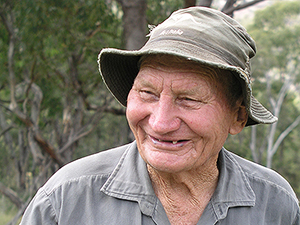
Bill Goebel.
|
|
So you'll continue to share his knowledge, his experiences, his passion?
Yeah. I want to continue his legacy. I'll make sure that he's not forgotten, as well as the fifty other people who've worked here. But Bill Goebel, he was a very special man.
Do you have any interesting stories or anecdotes you'd like to share about him or other people?
One of the funniest was when he'd suggest that I'd crawl down the wombat burrows. He'd say, it's ok, I'll pull you out. And he would! He was a seventy year old man and he'd have to drag me out by my two feet!
So you actually did crawl into the burrows?
Oh yeah, I was stupid enough to. [Both laugh.] Never saw one. And I didn't actually think about there's probably snakes and spiders and all sorts of other things down there. No fear.
How deep are those burrows?
I guess the longest are probably only about ten meters. But some of these were only just under big rock outcrops...
Like caves?
Yeah, they might only be sort of five meters, for all we know. I don't know. It's the mystery. We've been working on cameras to see if we can get them into the burrows and find out what's going on underneath.
Remote controlled things on wheels or something?
We're on Mark Eight. John Cowburn had so many different versions that we trialled.
What about those cameras they put in sewerage tunnels, you know, the worms? Have you tried those?
Well, no. But that's, you know, you'd need money.
Well, that's true. Why not just get your local plumber?
Exactly!
So, do you have any other stories or funny jokes? I keep hearing tales that everyone's playing practical jokes on each other.
Oh look, it's always going on. You know, the boys... I call them my girlfriends, because [laughs] they crack me up. We laugh every day. They can be crude, they can be loving, they can be grumpy, but we'll just take the mickey out each other and, yeah, there's always practical jokes going on. I probably need to document a few.
You should for the next anniversary - the 60th anniversary!
Yeah...
|
|
Over the twenty years, has much changed around here?
For sure! I guess over the last decade, we've had a huge injection of money which has helped us upgrade a lot of our facilities that needed to be done. The day-use area is probably one of my biggest achievements here.
I was going to ask... You designed that, didn't you?
Pretty much. And the Wyberba Walk and all the interpretive displays. I kind of feel I've left my mark around here.
Well, sitting here in Gunn's Cottage, this is all your work as well?
Yes, this is all me...
The paintings on the walls and all these signs?
|
|
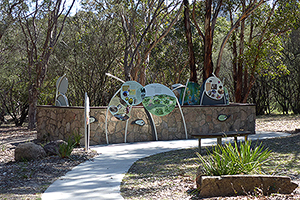
Interpretive display in the day-use area. The stone wall is from one of the original toilet blocks, repurposing a part of the park's structural history.
|
|
As I've said before, we're moving with the times but the trick is also acknowledging the history and making sure all those legacies continue to live on as well.
It's all a part of the place.
It is, yeah.
Well, thank you very much. I think that's everything I had to ask you. I'd better let you get back to doing your job!
Thank you.
|
|

